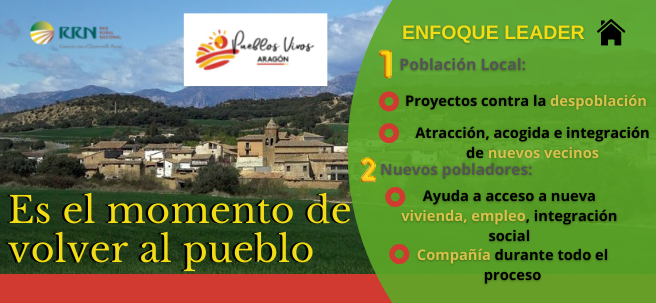
24 de November de 2021
"It's time to return to the village." Under this premise, several rural areas in Aragon are presenting themselves as a future alternative for those seeking a new way of life. At the same time, they are trying to stem the depopulation of their territories.
- The "Living Villages" project is a set of actions to help curb depopulation and encourage the settlement of new residents in rural areas of Aragon.
- This is a LEADER project in which 7 Local Action Groups actively participate.
- The project was a finalist in the 2019 European Rural Inspiration Awards.
To this end, "Pueblos Vivos" was created in 2017, an inter-territorial cooperation project with a LEADER approach aimed at establishing a population and attracting new residents through a series of actions involving a large network of volunteers and cooperators across the 10 participating Aragonese regions .
The project involves 7 Local Action Groups ( LAGs ) : Somontano Comprehensive Development Centre (Somontano de Barbastro region, Huesca); Cinco Villas Development and Promotion Association (Cinco Villas region, Zaragoza); Gúdar-Javalambre and Maestrazgo Development Association (Gúdar-Javalambre and Maestrazgo regions, Teruel); Sierra de Albarracín Rural Comprehensive Development Association (Sierra de Albarracín region and the municipalities of Alobras, Veguillas de la Sierra, El Cuervo and Tormón, Teruel); Campo de Belchite Rural Development Association (Campo de Belchite region); Jiloca and Gallocanta Lands Association (Campo de Daroca regions, Zaragoza and Jiloca, Teruel); and the Association for the Comprehensive Development of the Cradle of Aragon (regions of La Jacetania and Alto Gállego, Huesca).
The project is led by CEDER Somontano .
Line of actions
“Living Villages” is aimed at two large groups:
- Local population : These people constitute the large "network of collaborators," as information on the services and resources offered by the towns is gathered from town councils and residents. In turn, the local population is trained to combat depopulation and improve their ability to attract, welcome, and integrate new residents.
- New Residents: Potential new residents are contacted and supported throughout the entire settlement process in the new municipality.
The advice involves helping them to:
- Know the territory .
- Search for a home .
- Search for a job , with guidance and a weekly job offer newsletter.
- Define a business and get it started.
- Transferring a business or independent professional activity.
- Integrate into the social life of each municipality.
Next steps
Patricia Sanchón Ortas, a technician for the Pueblos Vivos project, explains to the RRN that "over these three or four years of implementation, we have developed a common working methodology among all the participating groups. Furthermore, we have carried out numerous awareness-raising activities in the region that are bearing fruit: training, meetings, and rental housing opportunities in different areas."
Regarding upcoming actions, Patricia announced that they will publish two guides developed for the project:
1. Guide for a good welcome : resulting from the experiences acquired in the project through the work carried out in rural communities with respect to new settlers.
2. Guide to starting local development processes: to launch local projects such as a shelter, a social enterprise with elderly clients, a housing fund to help people return, etc.
LEADER interterritorial cooperation
“Pueblos Vivos” is a project developed through the 2014-2020 LEADER grant, co-financed by the European Agricultural Fund for Rural Development ( EAFRD ) and funds from the Department of Agriculture, Livestock and Environment of the Government of Aragon.
The project began in early 2017 and is being implemented in three-year phases. The second phase of the project will continue until the end of 2022.
LEADER cooperation is one of the key components of the LEADER approach. For the period 2014-2020, it was programmed in submeasure 19.3 of the regional RDPs and is voluntary for Local Action Groups (LAGs).
The National Rural Network (RRN) facilitates inter-territorial cooperation between Local Action Groups (LAGs) and provides technical assistance through the following link .











